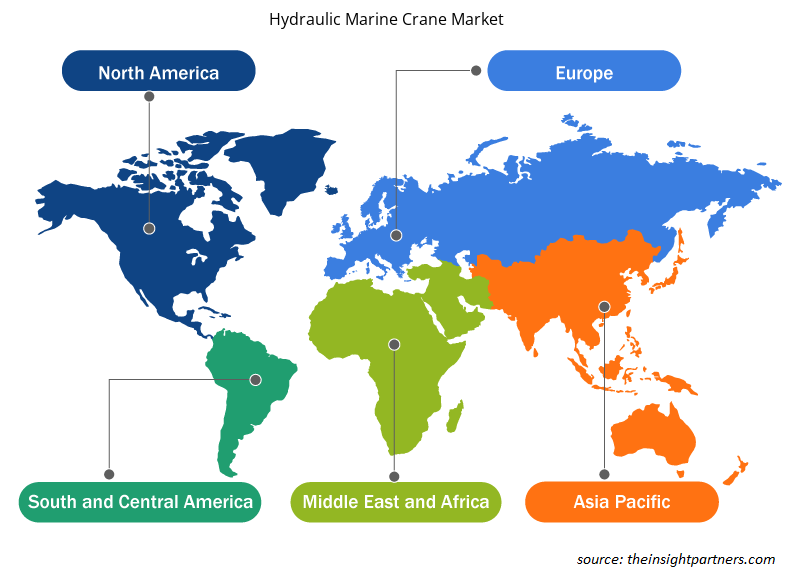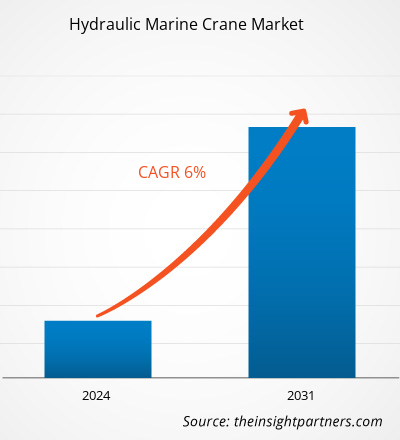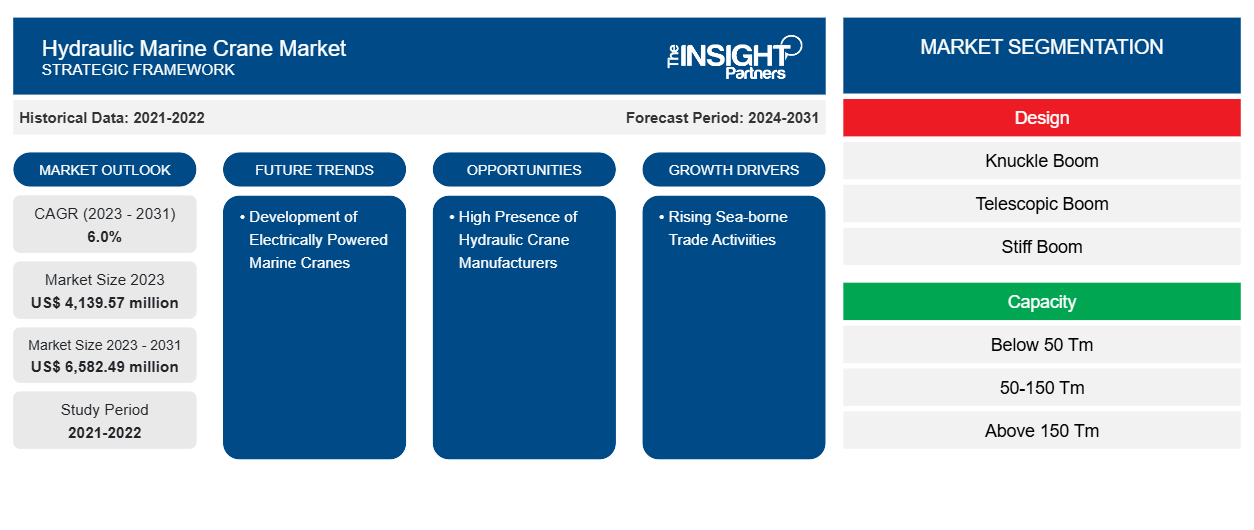Se proyecta que el tamaño del mercado de grúas marinas hidráulicas alcance los 6.582,49 millones de dólares estadounidenses en 2031, frente a los 4.139,57 millones de dólares estadounidenses en 2023. Se espera que el mercado registre una CAGR del 6,0 % durante el período 2023-2031. Es probable que el creciente número de actividades comerciales marítimas y el creciente enfoque gubernamental en el desarrollo de infraestructuras marinas sigan siendo una tendencia clave en el mercado.
Análisis del mercado de grúas marinas hidráulicas
Varias inversiones gubernamentales en la construcción de infraestructura marina han aumentado la demanda del mercado de grúas marinas hidráulicas. Una gran cantidad de fabricantes de barcos conduciría directamente a una mayor demanda de grúas marinas hidráulicas a nivel mundial. Las regiones desarrolladas como América del Norte y Europa tienen los principales fabricantes de grúas marinas, como DMW Marine Group y Fred Wahl Marine Construction, Inc., que ofrece grúas marinas de pluma articulada, pluma telescópica y pluma rígida. Todos ellos aumentarán el crecimiento del mercado de grúas marinas hidráulicas.
Descripción general del mercado de grúas marinas hidráulicas
Los crecientes avances tecnológicos permiten a los trabajadores seguir siendo ágiles. La integración de tecnología avanzada en los barcos y en varios proyectos offshore impulsaría el crecimiento del mercado de grúas marinas hidráulicas a nivel mundial. Países como Arabia Saudita están adquiriendo flotas de transporte marítimo que mejorarían el despliegue de tecnologías avanzadas en varios barcos, como buques de carga y buques de guerra, entre otros. Para implementar y construir nueva infraestructura tecnológica, se requeriría la necesidad de grúas marinas, lo que está impulsando la demanda de grúas marinas hidráulicas.
Personalice este informe según sus necesidades
Obtendrá personalización en cualquier informe, sin cargo, incluidas partes de este informe o análisis a nivel de país, paquete de datos de Excel, así como también grandes ofertas y descuentos para empresas emergentes y universidades.
- Obtenga las principales tendencias clave del mercado de este informe.Esta muestra GRATUITA incluirá análisis de datos, desde tendencias del mercado hasta estimaciones y pronósticos.
Impulsores y oportunidades del mercado de grúas marinas hidráulicas
Crecientes actividades comerciales marítimas favorecen el mercado
Las políticas y regulaciones gubernamentales a favor de las actividades comerciales internacionales atraen inversiones extranjeras. Además, varios gobiernos se centran en el desarrollo de la industria marítima y en atraer IED en este sector, lo que está aumentando las actividades comerciales marítimas e influyendo positivamente en el mercado de grúas hidráulicas. Los crecientes proyectos de desarrollo tecnológico construidos en puertos y en astilleros están influyendo positivamente en las actividades comerciales. El creciente número de actividades comerciales marítimas requiere infraestructura portuaria y muelles adecuados para atender a la gran cantidad de barcos comerciales, lo que actúa como un importante impulsor del mercado de grúas hidráulicas a nivel mundial.
Alta presencia de fabricantes de grúas hidráulicas
El número de fabricantes de grúas marinas en regiones como Europa, Asia Pacífico y América del Norte es alto en comparación con otras regiones. Italia, China y Estados Unidos se encuentran entre los principales países con los mayores fabricantes de grúas marinas. Los tipos de grúas marinas disponibles en estas regiones son grúas marinas de pluma articulada, de pluma telescópica y de pluma rígida. Por lo tanto, con un mayor número de fabricantes de grúas marinas presentes, se proyecta que el mercado tenga un crecimiento positivo. Estados Unidos también tiene una gran cantidad de fabricantes de barcos, lo que conduciría directamente a una mayor demanda de grúas marinas hidráulicas.
Informe de mercado de grúas marinas hidráulicas Análisis de segmentación
Los segmentos clave que contribuyeron a la derivación del análisis del mercado de grúas marinas hidráulicas son el diseño, la capacidad y la longitud de la pluma.
- Según el diseño, el mercado de grúas marinas hidráulicas se divide en pluma articulada, pluma telescópica , pluma rígida y pluma plegable. El segmento de pluma plegable tuvo una mayor participación de mercado en 2023.
- Por capacidad, el mercado se segmenta en menos de 50 Tm, 50-150 Tm y más de 150 Tm. El segmento de 50 a 150 Tm tuvo una participación significativa del mercado en 2023.
- Según la longitud de la pluma, el mercado se segmenta en menos de 10 metros, entre 10 y 20 metros y más de 20 metros. El segmento de menos de 10 metros tuvo una participación significativa del mercado en 2023.
Análisis de la cuota de mercado de las grúas marinas hidráulicas por geografía
El alcance geográfico del informe de mercado de grúas marinas hidráulicas se divide principalmente en cinco regiones: América del Norte, Asia Pacífico, Europa, Medio Oriente y África, y América del Sur y Central.
Europa lidera el mercado. Las elevadas inversiones gubernamentales en el desarrollo de la infraestructura marina han influido positivamente en la demanda del mercado de grúas marinas hidráulicas en la región. Los crecientes proyectos de desarrollo tecnológico en los puertos y en la fabricación de barcos están aumentando la demanda de grúas marinas hidráulicas en los mercados europeos. Europa es una región económicamente avanzada. El Reino Unido, España, Italia, Francia, Alemania, Suiza, Rusia, Suecia y los Países Bajos son algunos de los principales países de la región. La elevada presencia de fabricantes de grúas hidráulicas y de construcción naval también está teniendo un impacto positivo en el mercado de grúas marinas hidráulicas en Europa.
Perspectivas regionales del mercado de grúas marinas hidráulicas
Los analistas de Insight Partners explicaron en detalle las tendencias y los factores regionales que influyen en el mercado de grúas marinas hidráulicas durante el período de pronóstico. Esta sección también analiza los segmentos y la geografía del mercado de grúas marinas hidráulicas en América del Norte, Europa, Asia Pacífico, Oriente Medio y África, y América del Sur y Central.

- Obtenga datos regionales específicos para el mercado de grúas marinas hidráulicas
Alcance del informe de mercado de grúas marinas hidráulicas
| Atributo del informe | Detalles |
|---|---|
| Tamaño del mercado en 2023 | US$ 4.139,57 millones |
| Tamaño del mercado en 2031 | US$ 6.582,49 millones |
| CAGR global (2023 - 2031) | 6.0% |
| Datos históricos | 2021-2022 |
| Período de pronóstico | 2024-2031 |
| Segmentos cubiertos | A propósito
|
| Regiones y países cubiertos | América del norte
|
| Líderes del mercado y perfiles de empresas clave |
|
Densidad de actores del mercado: comprensión de su impacto en la dinámica empresarial
El mercado de grúas marinas hidráulicas está creciendo rápidamente, impulsado por la creciente demanda de los usuarios finales debido a factores como la evolución de las preferencias de los consumidores, los avances tecnológicos y una mayor conciencia de los beneficios del producto. A medida que aumenta la demanda, las empresas amplían sus ofertas, innovan para satisfacer las necesidades de los consumidores y aprovechan las tendencias emergentes, lo que impulsa aún más el crecimiento del mercado.
La densidad de actores del mercado se refiere a la distribución de las empresas o firmas que operan dentro de un mercado o industria en particular. Indica cuántos competidores (actores del mercado) están presentes en un espacio de mercado determinado en relación con su tamaño o valor total de mercado.
Las principales empresas que operan en el mercado de grúas marinas hidráulicas son:
- Amco Veba Marina
- Grupo marino DMW
- Fassi Gru SpA
- Construcción marina Fred Wahl, Inc.
- Grúas Heila SpA
- Industria hidráulica AB
Descargo de responsabilidad : Las empresas enumeradas anteriormente no están clasificadas en ningún orden particular.

- Obtenga una descripción general de los principales actores clave del mercado de grúas marinas hidráulicas
Noticias y desarrollos recientes del mercado de grúas marinas hidráulicas
El mercado de grúas marinas hidráulicas se evalúa mediante la recopilación de datos cualitativos y cuantitativos posteriores a la investigación primaria y secundaria, que incluye publicaciones corporativas importantes, datos de asociaciones y bases de datos. A continuación, se enumeran algunos de los avances en el mercado de grúas marinas hidráulicas:
- Amco Veba Marine lanzó grúas marinas de 40 tm. (Fuente: Amco Veba Marine, comunicado de prensa, mayo de 2022)
- Las grúas de las categorías V820NM y V823NM de Amco Veba Marine han sido certificadas por DNV como compatibles con la norma DNV-ST-0377 para dispositivos de elevación a bordo. (Fuente: Amco Veba Marine, comunicado de prensa, septiembre de 2022)
Informe de mercado de grúas marinas hidráulicas: cobertura y resultados
El informe “Tamaño y pronóstico del mercado de grúas marinas hidráulicas (2021-2031)” proporciona un análisis detallado del mercado que cubre las siguientes áreas:
- Tamaño del mercado de grúas marinas hidráulicas y pronóstico a nivel mundial, regional y nacional para todos los segmentos clave del mercado cubiertos bajo el alcance
- Tendencias del mercado de grúas marinas hidráulicas, así como dinámica del mercado, como impulsores, restricciones y oportunidades clave
- Análisis PEST y FODA detallados
- Análisis del mercado de grúas marinas hidráulicas que cubre las tendencias clave del mercado, el marco global y regional, los principales actores, las regulaciones y los desarrollos recientes del mercado
- Análisis del panorama de la industria y de la competencia que abarca la concentración del mercado, el análisis de mapas de calor, los actores destacados y los desarrollos recientes del mercado de grúas marinas hidráulicas
- Perfiles detallados de empresas
- Análisis histórico (2 años), año base, pronóstico (7 años) con CAGR
- Análisis PEST y FODA
- Tamaño del mercado, valor/volumen: global, regional y nacional
- Industria y panorama competitivo
- Conjunto de datos de Excel
Informes recientes
Informes relacionados
Testimonios
Razón para comprar
- Toma de decisiones informada
- Comprensión de la dinámica del mercado
- Análisis competitivo
- Información sobre clientes
- Pronósticos del mercado
- Mitigación de riesgos
- Planificación estratégica
- Justificación de la inversión
- Identificación de mercados emergentes
- Mejora de las estrategias de marketing
- Impulso de la eficiencia operativa
- Alineación con las tendencias regulatorias





















 Obtenga una muestra gratuita para - Mercado de grúas marinas hidráulicas
Obtenga una muestra gratuita para - Mercado de grúas marinas hidráulicas